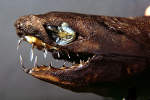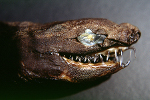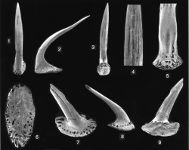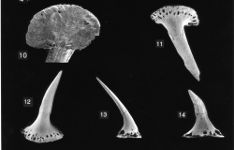Trigonognathus kabeyai
Mochizuki & Ohe, 1990
Viper dogfish
Classification: Elasmobranchii Squaliformes Etmopteridae
Reference of the original description
Trigonognathus kabeyai, a new genus and species of the squalid sharks from Japan. Japanese Journal of Ichthyology, 36(4), 385–390
Trigonognathus kabeyai, a new genus and species of the squalid sharks from Japan. Japanese Journal of Ichthyology, 36(4), 385–390
Image of the original description
Image in copyright.
Image in copyright.
Synonyms / new combinations and misspellings
Trigonognathus aff. kabeyai, Trigonotodus kabeyai
Trigonognathus aff. kabeyai, Trigonotodus kabeyai
Description :
Citation: Trigonognathus kabeyai Mochizuki & Ohe, 1990: In: Database of modern sharks, rays and chimaeras, www.shark-references.com, World Wide Web electronic publication, Version 10/2025
Please send your images of "Trigonognathus kabeyai" to info@shark-references.com

Trigonognathus kabeyai Mochizuki & Ohe, 1990 © Dr. Nicolas Straube, Curator of Ichthyology & Associate Professor, Department of Natural History, University Museum of Bergen

Trigonognathus kabeyai Mochizuki & Ohe, 1990 © Dr. Nicolas Straube, Curator of Ichthyology & Associate Professor, Department of Natural History, University Museum of Bergen
Common names
 Triangle-jaw lantern-shark,
Triangle-jaw lantern-shark,  Viper dogfish,
Viper dogfish,  Viper shark
Viper shark
 Triangle-jaw lantern-shark,
Triangle-jaw lantern-shark,  Viper dogfish,
Viper dogfish,  Viper shark
Viper shark
Short Description
Original diagnosis of MOCHIZUKI & OHE, 1990 [1685]: Two dorsal fins preceded by a spine: middle point of 1st dorsal fin base situated above midway between origins of pectoral and pelvic fins. Both jaws trianglar in shape. Shape of teeth similar in both jaws: unicuspid, slender. canine-like, without any cusplets or serrations, with weak thin fold on labial and lingual sides in anterior ones on both jaws; tooth at symphysis of each jaw longest; the numbers 7-1-7/7-1-7 in holotype, 8-1-8/8-1-8 in para type; inters pace between teeth very wide. Body and head covered by dermal denticles; most of the denticles on body and head roughly rhombic, swollen near central part, with about 10-40 facets on the dorsal surface of its crown. Many small round organs considered to be photophores, about 100 microns in diameter, present mainly on ventral surface of body and head. Preoral snout length very short. No barbels at nostrils. Caudal peduncle without lateral keels, or precaudal pits. Rear tip of pectoral fin rounded.
Original diagnosis of MOCHIZUKI & OHE, 1990 [1685]: Two dorsal fins preceded by a spine: middle point of 1st dorsal fin base situated above midway between origins of pectoral and pelvic fins. Both jaws trianglar in shape. Shape of teeth similar in both jaws: unicuspid, slender. canine-like, without any cusplets or serrations, with weak thin fold on labial and lingual sides in anterior ones on both jaws; tooth at symphysis of each jaw longest; the numbers 7-1-7/7-1-7 in holotype, 8-1-8/8-1-8 in para type; inters pace between teeth very wide. Body and head covered by dermal denticles; most of the denticles on body and head roughly rhombic, swollen near central part, with about 10-40 facets on the dorsal surface of its crown. Many small round organs considered to be photophores, about 100 microns in diameter, present mainly on ventral surface of body and head. Preoral snout length very short. No barbels at nostrils. Caudal peduncle without lateral keels, or precaudal pits. Rear tip of pectoral fin rounded.
Distribution
Northwest Pacific: Wakayama and Tokushima, Japan [1685]. Reported from the Hawaiian Islands [17640]. Source: www.gbif.org
Northwest Pacific: Wakayama and Tokushima, Japan [1685]. Reported from the Hawaiian Islands [17640]. Source: www.gbif.org
Size / Weight / Age
47.0 cm TL (male/unsexed; [3720]); 53.9 cm TL (female); max. published weight: 426 g [3720]; max. published weight: 760.0 g
47.0 cm TL (male/unsexed; [3720]); 53.9 cm TL (female); max. published weight: 426 g [3720]; max. published weight: 760.0 g
Remarks
shark-references Species-ID=7269;
shark-references Species-ID=7269;




















